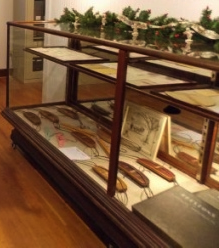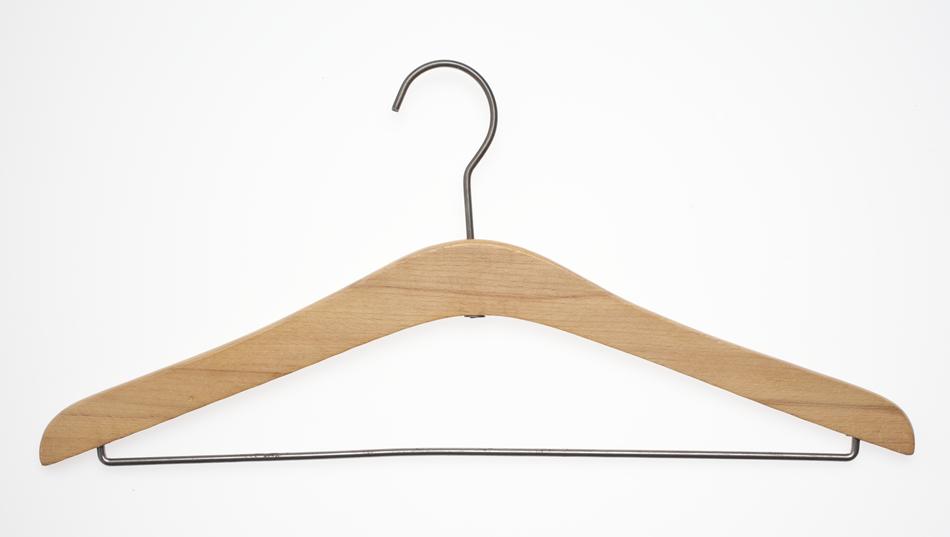History of Wooden Cloth Hanger
Wooden Cloth Hanger - History from 18th Century to present time
Its our human nature to take everything for granted and not bother about mundane topics as history of wooden hangers. The quality of our life has improved remarkably because of small or big inventions making our lives more comfortable. The wooden Cloth hanger is one such frequently used and never thought about item. Try living without cloth hanger for a few days and you will be presented with dysfunctional wardrobe and cluttered home.
Who invented cloth hanger

Antique hanger in museum
At first hangers were wooden hanger as wood was freely and cheaply available raw material in those days. It is believed that President Thomas Jefferson was the one who apart from other things also responsible for inventing this nifty utility. However, the one we use today, the hanger that is in shape of human shoulders, was invented in the year 1869 by New Britain’s O.A North, who took inspiration from a coat hook.
We can learn a lot about wooden hangers by visiting several museums around the world. In fact, There is an entire museum dedicated to coat hanger in Sweden. (Rättaregården, Pukaviksvägen 187, 29342 Olofström - Sweden, Phone: +46 (0)454400 96) or one can visit online galleries of The Museum of the Coat Hanger exhibiting hangers used by nobles, queens and kings. Some notable hangers (they named hangers in those days) include Etron that was designed in 1840 by Stanley Fry of Birmingham, England as a wedding gift to Queen Victoria. This royal hanger was made of wooden frame adorning gold plated hook and lamb wool padding.
Faussaire is yet another museum piece, a hanger from Albert Trou’s workshop in Paris. A set of twelve hangers was made during circa 1808, the era of 14th Duke of Navarre. Those were cotton wool padded hangers on a wooden hanger stuffed with aromatic herbs and flowers. Yet another interesting hanger in the museum is Excelsior was designed by Reverend Aubrey Moon, published in the Hunter Catalogue of edition 1910-12, remained hugely unpopular and described as unfit to hang anything!
Until late 19th century hangers were used by rich nobles and royalties as they had more clothes that needed storage.
The focus at that time was about hanging Victorian dresses so hangers resembling flying birds known as the Eagle Wing Hangers were popular.
We can learn a lot about wooden hangers by visiting several museums around the world. In fact, There is an entire museum dedicated to coat hanger in Sweden. (Rättaregården, Pukaviksvägen 187, 29342 Olofström - Sweden, Phone: +46 (0)454400 96) or one can visit online galleries of The Museum of the Coat Hanger exhibiting hangers used by nobles, queens and kings. Some notable hangers (they named hangers in those days) include Etron that was designed in 1840 by Stanley Fry of Birmingham, England as a wedding gift to Queen Victoria. This royal hanger was made of wooden frame adorning gold plated hook and lamb wool padding.
Faussaire is yet another museum piece, a hanger from Albert Trou’s workshop in Paris. A set of twelve hangers was made during circa 1808, the era of 14th Duke of Navarre. Those were cotton wool padded hangers on a wooden hanger stuffed with aromatic herbs and flowers. Yet another interesting hanger in the museum is Excelsior was designed by Reverend Aubrey Moon, published in the Hunter Catalogue of edition 1910-12, remained hugely unpopular and described as unfit to hang anything!
Until late 19th century hangers were used by rich nobles and royalties as they had more clothes that needed storage.
The focus at that time was about hanging Victorian dresses so hangers resembling flying birds known as the Eagle Wing Hangers were popular.
Hangers Manufacturing During Industrial Revolution
With the advancement of textile manufacturing cloths became cheap and common people were able to afford to buy more clothes. This gave rise to demand for hangers too.
The industrial revolution took off at a faster pace, allowing production of various styles of hangers in terms of shapes and materials. They added extra hook which enabled hanging belts, ties etc. Moreover, spring coiled wire was initiated in making new dimensions. Hangers for travelling purposes which can be folded to were also invented at that time.
The first factory produced hanger was Model M55 made by Steinway and Company, USA in 1885. Early 20th century saw a rise in hanger manufacturing. Cheap production of metal gave rise to wire frame hangers. Albert J. Parkhouse & Christopher of Timberlake Wire and Novelty Company’s employee were known as patent holder for it.
The Parkhouse’s hunger was improved in the year 1932 by Schuyler C. Hewitt, who even received a patent for the same. He added cardboard tubes to the hangers ensuring that the cloth hanged on the same are safe from wrinkles. The kind of hanger we use today was designed by Elmer D. Rogers in 1935 with a tube on the lower bar.
The first retailer displayed his goods on hangers was Meyer May of Grand Rapids, Michigan. He used wishbone inspired hangers to display garments in his store. This was way back in the year 1902.
During 1914, Ambrose Rice designed hangers made of molten steel. However, things changed after the First World War as its production halted and thereafter Rice also died. His younger son started his father’s unfinished task in 1945 and called it Stella PT 308 which was inexpensive and thus became very popular. He sold his patent to Bingley Associates in 1954. The company replaced it with a better model in mid-sixties known as WA-200.
The industrial revolution took off at a faster pace, allowing production of various styles of hangers in terms of shapes and materials. They added extra hook which enabled hanging belts, ties etc. Moreover, spring coiled wire was initiated in making new dimensions. Hangers for travelling purposes which can be folded to were also invented at that time.
The first factory produced hanger was Model M55 made by Steinway and Company, USA in 1885. Early 20th century saw a rise in hanger manufacturing. Cheap production of metal gave rise to wire frame hangers. Albert J. Parkhouse & Christopher of Timberlake Wire and Novelty Company’s employee were known as patent holder for it.
The Parkhouse’s hunger was improved in the year 1932 by Schuyler C. Hewitt, who even received a patent for the same. He added cardboard tubes to the hangers ensuring that the cloth hanged on the same are safe from wrinkles. The kind of hanger we use today was designed by Elmer D. Rogers in 1935 with a tube on the lower bar.
The first retailer displayed his goods on hangers was Meyer May of Grand Rapids, Michigan. He used wishbone inspired hangers to display garments in his store. This was way back in the year 1902.
During 1914, Ambrose Rice designed hangers made of molten steel. However, things changed after the First World War as its production halted and thereafter Rice also died. His younger son started his father’s unfinished task in 1945 and called it Stella PT 308 which was inexpensive and thus became very popular. He sold his patent to Bingley Associates in 1954. The company replaced it with a better model in mid-sixties known as WA-200.
Interesting facts about Hanger
- That In 1995, Professor Angus Wallace used a coat hanger, sterilized with brandy, to perform emergency surgery on Paula Dixon's lungs in an airplane at 35,000 feet !
- Antique hangers used by hotels in early twentieth century are finding markets with collectors and sell for over hundreds of dollars.
- The hanger is the most common item used in school's do it yourself projects..
- Hangers are the most common item stolen from hotel ranking below towels of course. This is the main reason for invention of anti theft hangers.
- Wire hangers were used as weapons in 2008 Movie Birdemic: Shock and Terror.

